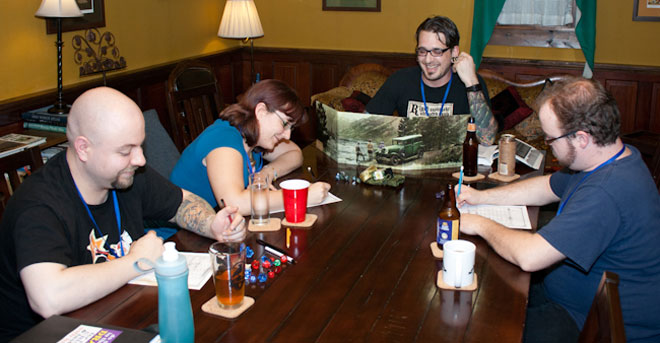In the GM’s Journal we will discuss all things role playing. From tips for running a successful table to reviews of various systems, you’ll find it here.
Imagine, if you will, this scenario: You are sitting around a table enjoying an eventful evening of roleplaying. But then the plot takes a turn for the worst. Suddenly, things aren’t going according to plan. Nothing is working. Tempers are flaring. Then someone goes for their blaster. Someone else draws their longsword. The tension mounts as players prepare to resolve combat! Almost every roleplaying system contains rules for resolving combat & conflict. Yet as exciting as combat can be, a long drawn out combat can fall flat as players grow restless and disengage. I wanted to take a minute to talk about some of the tricks that I have used to keep combat from bogging down.
The first question that you should ask yourself before a combat starts is this, “How important is this combat?” This is an important litmus test and can tell you how long you should spend resolving it. If the answer to the above question is ‘not very,’ then you should not waste much time on it. Fudge rolls, reduce enemy hit points, have the NPCs retreat, or do what you must to move the story along.
The next tip that I offer all Game Masters in regards to combat is this: keep it moving. Don’t stop to check the rules. Nothing is more boring to players than to watch their Game Master paw through the rule book searching for what provokes an attack of opportunity. Make a ruling, jot down a note, and move on. You can always look up the rule later. You can’t always get the excitement of the moment back when combat bogs down.
Always try to keep your combat fresh. Your players can only fight kobolds so many times before they realize that they have already fought this fight. Mix it up. Give them new and powerful adversaries to challenge. Have a battle on top of a collapsing building. Turn a combat into a chase scene, with players trying desperately to capture or avoid an adversary. Let them fight giants while on the back of wyverns. Pull out all the stops. Do whatever it takes to make combat interesting. Your players will love it.
Instead of using miniatures and a map to keep track of relative location, use the ‘theatre of the mind’ method. Let your players keep track of their tactical positions in their mind. This allows combat to flow more fluidly as your players won’t waste valuable time fiddling with miniatures. When using this method if a player asks you, “Am I close enough to attack?” and it is within the realm of possibility, give it to them. It makes combat much more interesting for the players. Nothing is more frustrating than not being able to do anything round after round.
The most important thing to remember is to keep players interested and keep them engaged. If they are not, they will quickly lose focus and become bored. This can further slow combat down and increase frustration among players. It may seem counterintuitive, but if your players are growing restless during a combat: take a break. Sometimes everyone needs to focus on something else for a few minutes before diving back into combat.
I hope that some of these tips help shorten your combats. Always try to keep your group focused and engaged. Don’t forget to keep your battles fresh and interesting and don’t worry about checking the rules. If you need to, take a break! Good luck and remember: keep that combat moving!
Karington Hess is a lifelong gamer whose passions for hospitality and all things game-related led him to Ravenwood Castle, where he served as an Innkeeper before joining The Malted Meeple. When not pouring beers, crafting milkshakes, or teaching boardgames, Karington can be found behind the DM’s screen, weaving intricate stories for his fellow gamers.

